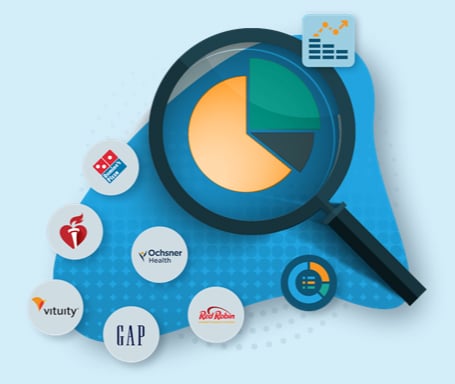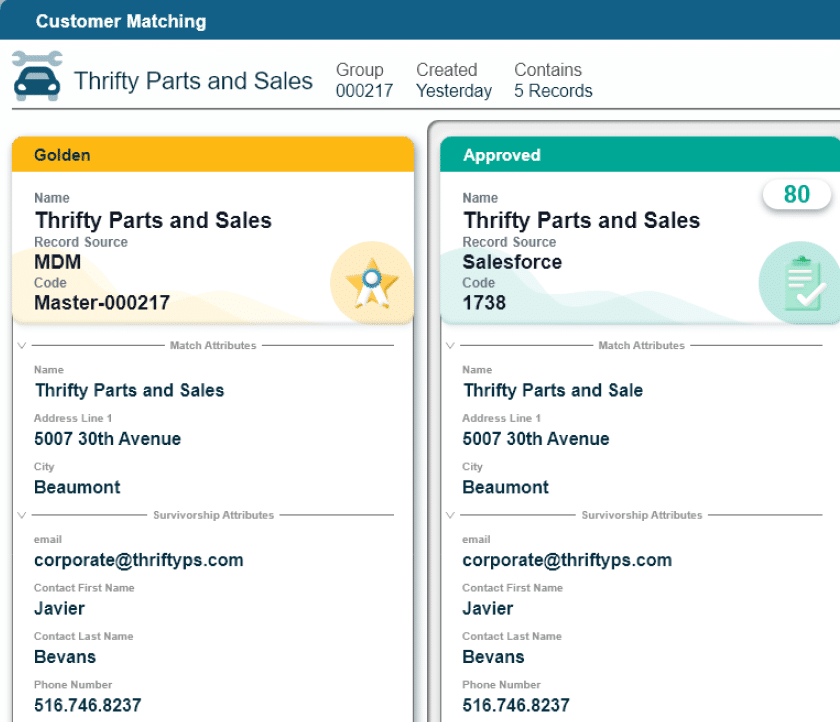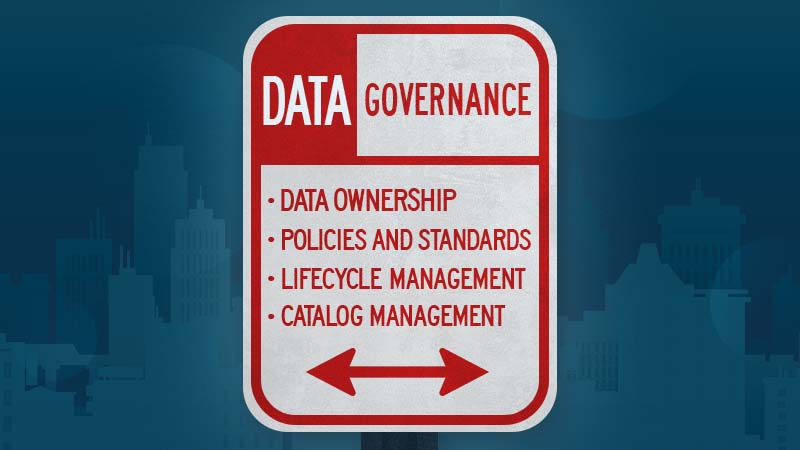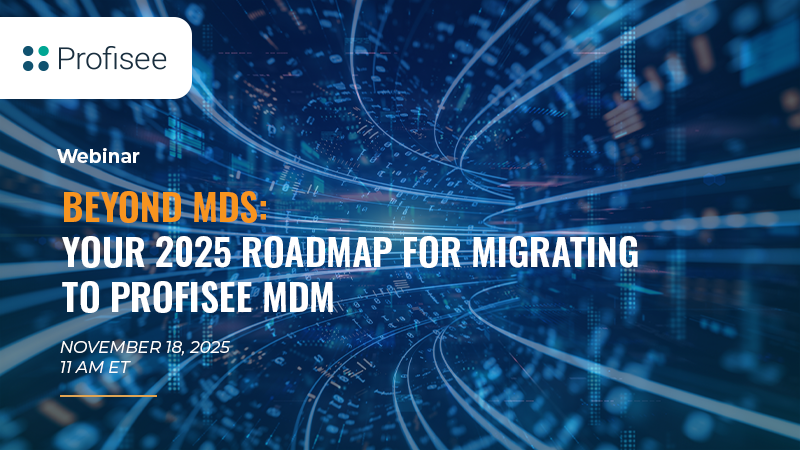Table of Contents
- What Is Master Data Governance?
- Master Data Management vs. Data Governance: Key Differences
- Why Is Master Data Governance Important?
- Core Components of a Master Data Governance Framework
- How to Implement a Master Data Governance Strategy in Practice
- Master Data Governance Best Practices for Success
- Master Data Governance Tools and Technology
- Enforce Master Data Governance Processes with Profisee
- Frequently Asked Questions
Key Takeaways
Master data governance consists of the practices, technology and people that maintain the quality of master data for an organization.
A master data governance framework defines the policies, processes, standards, responsibilities and technology that the governance plan works from.
Securing the right leadership and technology are key factors to a successful master data governance initiative.
Profisee MDM enhances a solid master data governance strategy with flexible integrations and powerful master data management.
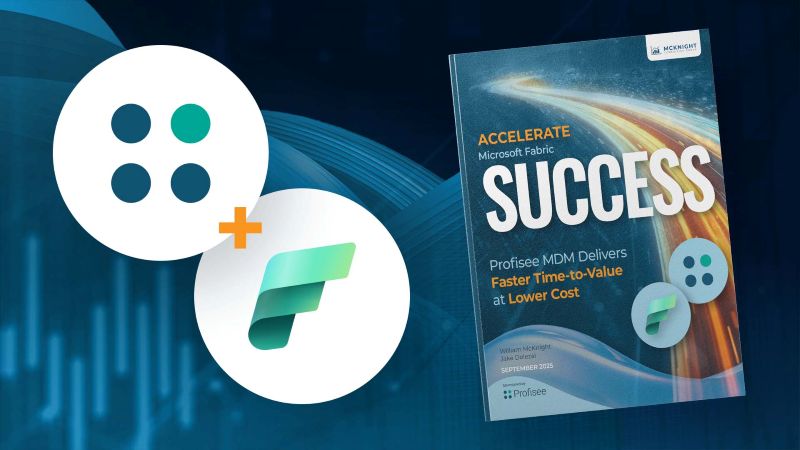
Accelerate Microsoft Fabric Success
What Is Master Data Governance?
Master data governance consists of the policies, processes and people that an organization implements to obtain and maintain the most usable data available and use it as a single source of truth to guide the company.
Master data governance defines:
- Data ownership: Who maintains the data?
- Data policies and standards: The formats, naming conventions and other rules that guide how reliable data is stored and used in the systems.
- Data lifecycle management: Who is in charge of and what processes are used at every point in the data lifecycle from creation or discovery to deletion.
- Catalog management: A documented index of all data elements, their uses and any changes.
Master data governance should be a part of larger data governance policies and procedures, as master data governance defines the discovery, ingestion and mastering of master data — data that drives key operational processes but does not change often, including product, supplier, customer, employee, material and location data.
Master Data Management vs. Data Governance: Key Differences
Master data management and master data governance exist as parts of a more comprehensive data governance plan that might include risk assessments, compliance concerns and restrictions around how data can be used in the organization.
- Master data management guides the lifecycle for master data in particular, deciding how master data is discovered, consolidated, cleansed, de-duplicated, standardized and shared across the organization.
- Data governance is the process that defines policies for all data, including master data, that is created and used by the organization. Data governance dictates data quality standards as well as policies around data retention, data formatting, identity and access management and data storage, among others.
The table below shows the focuses, benefits and stakeholders involved in master data management, master data governance and data governance. These definitions overlap as master data is a subset of the larger data universe an organization exists within.
| Aspect | Master Data Management | Master Data Governance | Data Governance |
|---|---|---|---|
| Focus | Managing master data lifecycle | Governing core data domains | Policies for all data |
| Key benefits | Clean, unified and standardized master data | Quality, consistency, usability | Quality, compliance, access, security |
| Stakeholders | IT, data stewards, business users | Stewards, owners | Governance council |
Why Is Master Data Governance Important?
Master data governance builds the framework that supports the most vital data domains for a business. Because master data includes the foundational data that businesses run on, a lack of governance of master data opens the business up to many potentially negative results. Inaccurate reporting, regulatory compliance risks, operational inefficiencies and poor partner or customer experience can all impact business agility and the bottom line.
With master data governance in place, businesses can benefit from the organized and reliable master data it produces. Some of those benefits include:
- Improved decision-making
- Better regulatory compliance
- More insightfulanalytics
- AI enablement
- Fewer duplicated efforts and errors
- Cost savings
- Improved customer experience
Master data governance creates an atmosphere of cooperation and cohesion around reliable and usable data that often results in greater business resilience and agility.
Core Components of a Master Data Governance Framework
A master data governance framework’s core components work together to ensure that people, processes and technology work together to ensure the most reliable data is available to the organization at all times. Think about how your organization will form these four components before beginning to plan your master data governance initiative.
Policies and Standards
Policies and standards within a master data governance framework define what quality data looks like, where it should be improved and how it is stored within the technology. Policies and standards should include naming conventions, data validation rules, acceptance thresholds, data matching criteria and other rules or standards that determine data quality.
It may be tempting to build data policies that fit how data is stored in a single piece of technology, but as Profisee VP of Strategic MDM Programs Christopher Dwight says, “…[within heterogeneous data organizations] the ideal master data model will not look like any one system because you need your master data to support multiple systems.”
This means modeling the data in a way that makes sense for all business users, across all systems. For example, you might set a naming convention policy to always store names in “last name, first name” format, even though Salesforce might default to storing names in “first name, last name” format and NetSuite might default to “first initial, last name.”
Processes
Master data governance processes define how data moves within the organization and its technologies. Workflows, automations and process documentation that define the order of events and key checkpoints that assure the creation and maintenance of usable data all fit under the processes umbrella.
Consider, for example, how data might flow from ERP, product information management and CRM systems into a data lake or warehouse, where it can then be governed by policies set in Microsoft Purview and Profisee.
Roles and Responsibilities
Roles and responsibilities documentation defines who owns what master data, the circumstances under which they own that data and the workflows and remediations that should be used to ensure the quality of that master data. Data owners and stewards should include stakeholders within data, IT and business departments so usability is prioritized.
For example, you might establish a policy that the sales organization owns customer data and is responsible for creating new customer records and updating existing records as needed. The same could be done for the research and development department and owning product data.
Technology
Organizations need the right technology to make the best use of master data. This usually means implementing a master data management tool like Profisee in tandem with a data governance tool like Microsoft Purview to ensure data is governed, integrated, cleansed and standardized so that it can be used by other systems.
An MDM and data governance tool should play nice with the business’s existing systems and be able to handle multiple data domains. For instance, using Profisee for Microsoft Azure MDM lets you easily integrate data from all your business systems with the different tools you use in the Azure ecosystem, like Azure Synapse Analytics and Azure Data Studio.
How to Implement a Master Data Governance Strategy in Practice
A master data governance strategy takes plenty of planning and legwork to implement properly, and every organization will need to make changes based on their unique situations, including industry, corporate structure or technology adoption maturity. Most companies will find that their strategy should proceed in these six steps.
1. Define Governance Objectives and Scope
The first step in this or any business initiative is to define the objectives and scope of the project. Objectives should work as a component of a larger business initiative, perhaps to increase organizational cooperation or provide a unified customer experience. Scope should be manageable and restricted to a single domain for the initial project to maintain a manageable amount of work and prevent scope creep.
2. Establish Governance Council
A governance council will include the primary stakeholders for each of the departments that will engage in the master data governance initiative throughout the business. The governance council does not need to directly include the people who use the data directly, but rather leadership who understands the resources available to the department and who from the department can answer technical or process-focused questions related to daily data use.
3. Create and Document Policies
Create and document the policies that will guide the collection, creation, cleansing and storage of master data from across the organization. These policies will also dictate how data will be entered into systems for maximum quality, which will require change management planning to train existing employees on the systems. Documentation should also include explanations as to the purpose of each of these policies, as employees are more likely to adapt to changes when they understand why it’s happening.
4. Implement Stewardship Workflows
Data stewardship workflows ensure that the policies documented in the previous step follow a consistent process. These workflows should define not only how data moves through the organization and what data survives cleaning and deduplication, but also what stakeholders oversee the data quality. Detailed documented steps for any manual workflows will help with training and change management.
5. Enforce Governance Through MDM and Automation
Best practice to enforce data governance is to automate as many data workflows, policies and processes as possible, which removes the possibility of human error and can speed data processing. Master data management solutions with automation and workflow features like Profisee allow for governance by exception, which frees data practitioners to work on other key initiatives.
6. Monitor and Continuously Improve
Even the most well-designed system needs monitoring, as edge cases or previously unknown risks to the governance policies can and will pop up. Monitoring through MDM technology allows the data team to dial in their survivorship policies and tweak the governance standards to continue to improve. The lessons learned from the implementation of this governance project can then be applied to further master data domains.
Master Data Governance Best Practices for Success
In addition to the six main steps outlined in the previous section, these best practices can increase your chances of success when planning and implementing your master data governance strategy.
Secure Executive Sponsorship
Seek out an executive sponsor to champion your initiative with the leadership team. Your executive sponsor should understand and be able to clearly articulate the scope of organizational change and the benefits of the initiative. Finance, data or technology executives may be the obvious candidates, but don’t overlook customer success, sales or marketing leaders who understand the potential positive impact of master data governance.
Start Small and Scale Governance Policies
Starting a master data governance initiative with a single master data domain (location, product, supplier, etc.) can increase the likelihood of success in two major ways:
- It simplifies and reduces the scope of the project, which can result in faster and more successful results the first time through.
- When the team faces challenges, the impact of delays or disruptions is limited, and the team can learn from those challenges with future iterations.
Once the team has gone through their first round of master data governance — and analyzed the results for lessons learned — the scope and scale of the project can expand to include other data domains or to go from supporting an analytical to an operational use case.
Ensure Cross-Department Alignment
No one likes being told what to do without good reason, and a master data governance initiative is no exception. Gathering cross-departmental alignment, if not support, improves the chances of success as more departments and leaders are invested in the potential pay-off. These leaders and stakeholders can also champion the project with their teams, freeing the central project team from further marketing across the organization.
Use Automation to Reduce Manual Enforcement
Automation takes much of the policy enforcement out of the hands of the project team. This allows the team to focus on analysis and improvement rather than continual data cleansing because teams or individuals aren’t following the new policies. For example, configuring data validation (e.g., US telephone numbers must be 10 characters long and can only use Arabic numerals) within the systems data stewards use day in and day out can go a long way towards preventing data from being entered incorrectly in the first place.
Integrate Governance into Everyday Workflows
Wherever possible, business teams should build the new governance policies into their everyday workflows, and data teams should help business users understand the connection between data governance and positive business outcomes. Making governance an everyday occurrence reinforces its importance to business users, increases the likelihood of adoption and success and improves alignment across the business units. Just as everyone hopes to benefit from reliable data, everyone is responsible for creating reliable data.
Master Data Governance Tools and Technology
Data governance tools like Microsoft Purview, Collibra, Atlan and Ab Initio are popular picks for many companies, but it’s important to do your homework first to make sure the solution you choose is right for your company. Here are the most important capabilities to look for:
- Policy enforcement: The “govern” in governance should be seamlessly supported by your data management software, employing automation and AI-powered policy enforcement wherever possible. It’s common for data governance tools to integrate with other tools like MDM to handle the actual enforcement of data governance policies, so see our item in this list on integration with MDM platforms.
- Data quality monitoring: Even with the best policies in place, data quality can slip, requiring extra work to bring data quality back up to standard. Data quality monitoring features alert stakeholders to anomalies or changes that could impact quality.
- Stewardship workflows: Documented and automated stewardship workflows like those found in Profisee MDM guide data through established workflows, upholding standards without manual oversight.
- Metadata and lineage tracking: These features support audits of the governance policies to identify misalignments or to correct workflows according to new needs.
- Integration with MDM platforms: Governance technology must work closely with your MDM platform. Consider working with a vendor agnostic MDM like Profisee, which can connect to a heterogeneous data environment.
Remember: MDM and data governance tools work better together. A data governance tool is a powerful addition to your tech stack that can help you create usable data, but they work best when paired with the right MDM solution. Modern MDM tools like Profisee work with your DG tool, using automated workflows, AI-powered fuzzy matching and flexible integrations with governance tools and data sources to make governance and MDM execution easier and more consistent.
Enforce Master Data Governance Processes with Profisee
Master data governance is essential for the ongoing reliability and quality of any master data project. Implementing master data governance ensures the long-term success of the master data initiative by reinforcing the policies that produce quality data while making complications and outliers visible and available for correction.
Profisee MDM integrates seamlessly with your master data governance technology, employing automated data cleansing and AI-powered data matching that builds and maintains your organization’s golden records. Book a demo to see how Profisee can help you enforce a master data governance framework that works.
Solve Data Problems with Profisee MDM
Frequently Asked Questions
What is SAP Master Data Governance?
What industries benefit most from master data governance?
Nearly every industry benefits from master data governance, but enterprise companies within highly regulated industries and those with complicated or long supply chains like manufacturing, retail, healthcare, finance and pharmaceuticals. These industries benefit from the organizational speed and agility that master data management and master data governance provide.
What are the challenges in implementing master data governance?
Organizations might run into some of these challenges when implementing master data governance:
- Regulatory restrictions that complicate governance policies
- Technology that does not integrate across the organization
- Data silos created by disconnected departments or technology that hinder unified data governance
- Lack of resources needed to perform the initial governance strategy and maintain master data governance for the long term
- Resistance to change in processes or technology from data business users who create or use the data
- Quality issues stemming from partially implemented or insufficient governance policies
Poor stakeholder alignment that delays improvements, hampers work or causes scope creep
What is the future of master data governance?
Master data governance will benefit in the coming years from the increased use of augmented data management, agentic AI and further migration of legacy, on-premises systems to the cloud. These technologies will help organizations collect usable data upon entry and more quickly and efficiently master that data as it moves through the organization.

Tamara Scott
Tamara Scott is a writer, editor and content strategist with over a decade of experience located in Nashville, TN. Tamara holds a Master's in English from Belmont University, formerly served as Director of Content for TechRepublic, and her work has appeared in ServerWatch and EPI-USE.com, among others. When she's not crafting SEO-informed and conversion-ready content for SaaS and IT service companies, she's probably at home on her pottery wheel. Connect with her on LinkedIn.
